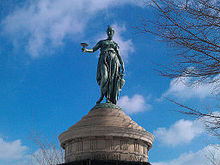Lifting (mythology)

Hebe ( Greek Ἥβη "youth") is the goddess of youth in Greek mythology , "the goddess with the rose cheeks". The Roman equivalent of Hebe is Iuventas .
myth
Hebe is the daughter of Zeus and Hera and the sister of Ares , Eileithyia and Hephaestus .
She is cupbearer of the gods and serves nectar and ambrosia . After an awkwardness, she is replaced by Ganymede . After the hero Heracles was burned and raised to Olympus , the gods gave him Hebe to wife. From him she has the children Alexiares and Aniketus .
Hebe had the power to give people a new youth. Thus, on Zeus 'command, she renewed the youth of Iolaos , Heracles' nephew.
Cult and representation
In Greece, Hebe was worshiped in the following places:
- together with Hera in Mantineia . The cult images of Hera, Athene and Hebe were works of Praxiteles .
- together with Hera in the Heraion of Argos , where her cult image made of gold and ivory - a work of Naukydes - stood next to the cult image of Hera.
- together with Herakles in Athens and Kos
- under the name Dia in Sikyon and Phleius . Pausanias also reports a cult of the Hebe in Phleius, where it was called Ganymeda after him. Her sanctuary is an asylum site and is associated with a festival called Kissotomoi (ivy cut).
Nothing of the cult images mentioned has survived. Hebe is often shown in her role as cupbearer on vase pictures. Her attribute is a jug from which she serves nectar to the gods. The figure is often winged, so it is not clear whether it is Hebe or Iris .
In modern times Antonio Canova , Bertel Thorvaldsen and Joseph Wackerle (Botanical Garden Munich) created sculptures of the Hebe.
See also
literature
- AF Laurens: Hebe . In: Lexicon Iconographicum Mythologiae Classicae (LIMC). Volume IV, Zurich / Munich 1988, pp. 458-464.
- Ludwig von Sybel : Hebe . In: Wilhelm Heinrich Roscher (Hrsg.): Detailed lexicon of Greek and Roman mythology . Volume 1,2, Leipzig 1890, Sp. 1869–1871 ( digitized version ).
Web links
- Lifting the Theoi Project (Engl.)
Individual evidence
- ↑ Hesiod Theogony 921; Homer Odyssey 11,601
- ↑ Cicero De natura deorum 1.40
- ↑ Diodorus 4.75
- ↑ Homer Odyssey 11.605
- ^ Libraries of Apollodorus 2.158
- ↑ Ovid 's Metamorphoses 9.396ff
- ↑ Pausania's description of Greece 8.9.2f
- ↑ Pausanias 2.17.5
- ↑ Pausania's description of Greece 1.19.3
- ↑ Cornutus Theologiae Graecae compendium 31
- ↑ Strabon Geographika 8.6.24
- ↑ Pausanias 2.12.4, 2.13.3



